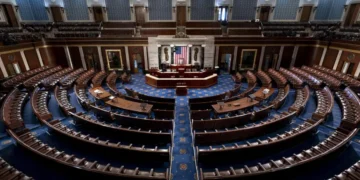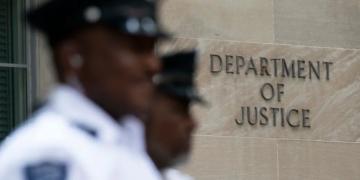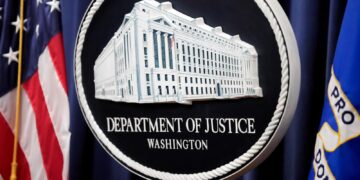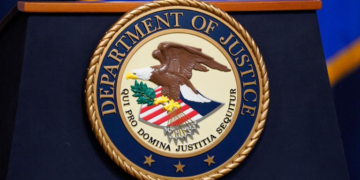Kevin Lamarque/Reuters
Aug 02, 2024 Story by: Editor
A recent report from the Department of Homeland Security’s internal watchdog sheds light on the challenges faced by the U.S. Secret Service during the chaotic events of January 6, 2021. On that day, a mob of supporters of then-President Donald Trump violently stormed the U.S. Capitol, posing significant security risks to high-ranking officials including the president, vice president, and vice president-elect.
The report, obtained by ABC News, offers a detailed account of how Kamala Harris, who was then vice president-elect, came dangerously close to a “viable” pipe bomb planted outside the Democratic National Committee’s (DNC) headquarters. The explosive device, hidden in the bushes, had been placed the night before but was not discovered during the Secret Service’s initial security sweeps of the area.
According to the report from DHS Inspector General Joseph Cuffari, which was shared with Congress, the Secret Service’s advance sweeps of the DNC building failed to include the outdoor area where the pipe bomb was hidden. Two canine teams assigned to secure the building were reportedly “surprised” to learn that additional support would not be provided, although the report notes that Secret Service protocols at the time required fewer resources for officials who had been elected but not yet inaugurated.
The report states that Harris, traveling in an armored vehicle, entered the DNC building via a ramp within 20 feet of the pipe bomb. The device was not discovered until an hour and 40 minutes after her arrival, and it took the Secret Service another 10 minutes to evacuate her from the premises. In total, Harris spent about one hour and 50 minutes inside the building before the threat was identified.
In response to the incident, the Secret Service has since revised its policies to ensure more assets are allocated for “elect” protectees, according to the heavily redacted report.
Despite ongoing investigations, federal authorities have yet to identify the individual responsible for planting the pipe bomb outside the DNC, as well as a similar device found at the Republican National Committee’s headquarters nearby. The FBI is offering a $500,000 reward for information leading to an arrest and has released security camera footage showing the suspect walking in the area.
“Although these bombs did not detonate, it is important to remember the suspect walked along residential and commercial areas in Capitol Hill just blocks from the U.S. Capitol with viable pipe bombs that could have seriously injured or killed innocent bystanders,” the FBI said in a statement earlier this year, urging the public to assist in identifying the suspect. “Moreover, the suspect may still pose a danger to the public or themselves.”
The release of this report comes at a time when the Secret Service is under intense scrutiny for its handling of recent security breaches. Just weeks ago, a 20-year-old Pennsylvania man nearly succeeded in assassinating Donald Trump, prompting the agency’s acting director, Ronald Rowe, to testify before Congress about the “multiple levels” of failure that allowed the threat to escalate.
Cuffari’s report highlights communication breakdowns and missed warning signs that affected the Secret Service’s response on January 6. The report notes that the agency was focused on protecting Trump at his “Save America” rally on the Ellipse, Mike Pence at the U.S. Capitol as he oversaw the certification of the 2020 election results, and Harris at the DNC building.
The Secret Service, like other law enforcement agencies, expected the Ellipse rally to resemble previous pro-Trump events in Washington, which had seen limited violence. However, as the rally progressed, the Secret Service detected signs of potential violence among the crowd, including individuals attempting to enter secured areas with ballistic vests and gas masks.
By the time Trump concluded his speech, the Secret Service had confiscated hundreds of weapons and other prohibited items. At 2:13 p.m., just over an hour after Trump’s speech ended, rioters breached the Capitol building.
The report describes how communication challenges and inadequate contingency planning nearly resulted in harm to Pence, with some rioters directly threatening the vice president. Significant portions of the report are redacted, but it mentions that agents faced “manpower challenges” and failed to receive critical communications from various entities during the unfolding crisis.
In response to the events of January 6, the report offers several recommendations for improving the Secret Service’s preparedness and agility. The agency has indicated that it is already in the process of implementing many of these recommendations.
The report also touches on two controversial aspects of January 6, including Trump’s alleged demands to go to the Capitol as the situation there escalated. In June 2022, former White House aide Cassidy Hutchinson testified to the House select committee investigating the January 6th attack, claiming that Trump had attempted to grab the steering wheel of his limousine and lunged at a Secret Service agent when his demand to go to the Capitol was denied.
However, in the DHS report, former White House deputy chief of staff Tony Ornato stated in writing that he does “not recall being made aware of any [such] details” and does not remember discussing the incident with anyone. Trump’s lead Secret Service agent also claimed he could not recall how Trump reacted when told he couldn’t go to the Capitol, though the limousine driver noted that Trump was visibly angry.
Cuffari’s report also details efforts by his office and “multiple committees of Congress” to obtain communications from the Secret Service, including phone records and text messages. However, these efforts were reportedly hindered because the Secret Service had “wiped all phones” as part of a software update in the weeks following January 6, leaving many communications unattainable.
In response, the Secret Service asserted that the phone wipe was not conducted with nefarious intent, as the software update had been planned well before January 6. “It is reassuring that the [inspector general] report does not state anywhere that any Secret Service text messages were inappropriately deleted,” the agency wrote in a letter responding to the report.
Following the attack on the Capitol, members of Congress demanded a wide range of records from the Department of Homeland Security, including communications from within the Secret Service. However, the agency was unable to provide the requested Secret Service text messages, leading Rep. Bennie Thompson (D-Miss.) to remark, “We could have had a better and more thorough report had we had access to all those records.” Source: ABC Newst messages. However, these efforts were reportedly hindered because the Secret Service had “wiped all phones” as part of a software update in the weeks following January 6, leaving many communications unattainable.
In response, the Secret Service asserted that the phone wipe was not conducted with nefarious intent, as the software update had been planned well before January 6. “It is reassuring that the [inspector general] report does not state anywhere that any Secret Service text messages were inappropriately deleted,” the agency wrote in a letter responding to the report.
Following the attack on the Capitol, members of Congress demanded a wide range of records from the Department of Homeland Security, including communications from within the Secret Service. However, the agency was unable to provide the requested Secret Service text messages, leading Rep. Bennie Thompson (D-Miss.) to remark, “We could have had a better and more thorough report had we had access to all those records.” Source: ABC News

















